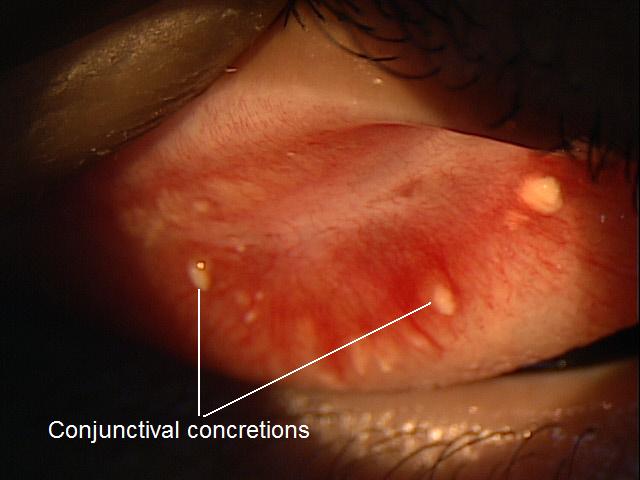ICD-10 Diagnosis Codes:
H11.121–Conjunctival concretions, right eye
H11.122–Conjunctival concretions, left eye
H11.123–Conjunctival concretions, bilateral
Title
Conjunctival Concretions
Category
Disorders Of The Conjunctiva
Description
A conjunctival concretion is a type of conjunctival degeneration. The lesions are yellow or white in appearance and are usually seen on the palpebral conjunctiva or in the fornix of the eye
A conjunctival concretion is a type of conjunctival degeneration. Individual or multiple concretions may be present. The lesions usually appear as a yellow or white mass on the palpebral conjunctiva or in the fornix of the eye. Although conjunctival concretions may enlarge slowly over time, most lesions are benign and do not require treatment.
Conjunctival concretions are granular membranous lesions composed of mucus secretions from conjunctival glands and degenerated epithelial cells. Conjunctival concretions are often associated with aging, blepharitis, and blepharoconjunctivitis.
Functional Damage to the Eye
- Decreased vision as a result of the punctate epitheliopathy of the cornea
The main goal of the diagnostic evaluation in a patient with conjunctival concretions is to accomplish the following:
- Determine whether or not the concretions are causing patient symptoms
- Determine whether or not the concretions are causing any symptomatic response or corneal damage
- Determine if an associated condition such as blepharitis is present
- Prescribe a treatment program
Patient History
Patients with conjunctival concretions usually present with little to no complaints. The most common question from the patient is, “What is this little white thing on my eyelid?”
Patients with clinically significant conjunctival concretions may present with any of the following abnormal symptoms:
- Foreign body sensations
- Red eyes
- Decreased vision
- Contact lens intolerance
External Ocular Examination with Biomicroscopy
External Ocular Photography
- Document the number and size of the conjunctival concretions
- Document any damage to the conjunctiva
- Document any damage to the cornea
- Plan the treatment of the conjunctival concretions
No specific classification system exists for conjunctival concretions.
No differential diagnoses to consider.
Patients with conjunctival concretions can be observed if there are no abnormal clinical signs or symptoms.
Palliative Treatment
- Treatment with artificial tears if foreign body sensations exist
- Treatment with warm compresses if blepharitis is present
Pharmacologic Treatment
- Treatment with topical steroids or other anti-inflammatory eye drops if artificial tears are ineffective
- Treatment of associated conditions such as blepharitis if it is present
Surgical Treatment
- Treatment with surgical excision by needle tip if persistent foreign body sensations or topical lubrication and anti-inflammatory treatment does not provide sufficient relief
1. RevOptom. Handbook of Ocular Disease Management. Conjunctival Concretions (Ocular Lithiasis). http://www.reviewofoptometry.com/cmsdocuments/2011/4/ro0411_hndbk_em.pdf. Last accessed August 14, 2014.
372.54
Conjunctival concretions
92285
External ocular photography
92071
Bandage contact lens
Occurrence
The prevalence of conjunctival concretions is almost 6% of the population.
Distribution
Conjunctival concretions are distributed evenly throughout the population.
Risk Factors
- Advancing age
- Chronic conjunctivitis
- Blepharoconjunctivitis
- Meibomian gland dysfunction




 Print | Share
Print | Share

